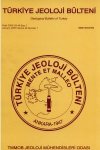
-
2024
-
2023
-
2022
-
2021
-
2020
-
2019
-
2018
-
2017
-
2016
-
2015
-
2014
-
2013
-
2012
-
2011
-
2010
-
2009
- 2008
-
2007
-
2006
-
2005
-
2004
-
2003
-
2002
-
2001
-
2000
-
1999
-
1998
-
1997
-
1996
-
1995
-
1994
-
1993
-
1992
-
1991
-
1990
-
1989
-
1988
-
1987
-
1986
-
1985
-
1984
-
1983
-
1982
-
1981
-
1980
-
1979
-
1978
-
1977
-
1976
-
1975
-
1974
-
1973
-
1972
-
1971
-
1970
-
1969
-
1968
-
1966
-
1964
-
1963
-
1961
-
1959
-
1958
-
1955
-
1954
-
1953
-
1952
-
1951
-
1950
-
1949
-
1948
-
1947
Abstract: The study area covers the groundwater irrigation project area of the State Hydraulic Works (DSİ) inÇavuşköy village in the Sungurlu district of the Çorum province. The aquifer studied is an unconfinedalluvium which is recharged from precipitation and a stream. The aquifer`s thickness varies between 24m and 35 m, and the well yield ranges between 6 l/s and 20 l/s. High salinity values (Electricalconductivity, EC= 2150-2480 µS/cm) were encountered in groundwaters abstracted from the DSİirrigation wells in the Çavuşköy aquifer. For this reason, the level and spatial extent of EC, boron andresidual sodium carbonate (R.S.C) and the suitability of the groundwaters for irrigation wereinvestigated. The risk of salinization and the usability of the groundwaters for irrigation were evaluatedby interpreting results of chemical analyses of water samples collected first in 2003 and then repeated in2004, and of electrical conductivity logs and temperature logs, in the light of the existinggeological/hydrogeologic structure.According to the evaluation of all data mentioned above, the salinity of the groundwater in thelower part of the area is moderately high, while the sodium, boron and residual sodium carbonatecontents, which are generally significant limitations in irrigation, seem not to be problematic. Since nodrainage problem exists in the soils of the irrigation area, and the salinity tolerance of the crops alreadypreferred by the local farmers is rather high, it is suggested that salt resistant crop types must continueto be grown and that irrigation must be applied under the supervision of experts in order to minimize therisk of salinization.
Abstract: This study aims at determining the sedimentological and sedimanter petrographic features of, and thecorrelation between, Eocene aged volcanoclastic and siliciclastic characterized sandstones in theGümüşhane region.The thickness of the volcanoclastic sequence is 195 m. around Eski Gümüşhane and thethickness of the siliciclastic sequence is 280 m. around Ünlüpınar (Kelkit). The volcanoclastic sequenceis a composite of grey colored and medium, thick bedded limestone, grey, brown colored and thin,medium, thick bedded sandstone, green, grey, brown colored and thin, medium bedded marl-claystoneand tuff. The siliciclastic sequence is a composite of grey, yellowish brown colored and thin to thickbedded sandstone, and green, greenish grey, brown colored and thin, medium bedded marl. There isfrequently observed locally interbedded light grey, thin, medium bedded limestone, conglomarete andtuff.Sandstones of the Eski Gümüşhane sequence are median grained, well to moderately sorted andnear symmetrical to fine skewed. Sandstones of the Ünlüpınar sequence are medium to fine grained,very well sorted to poorly sorted and coarse skewed to fine skewed.The composite of the Eski Gümüşhane sequences sandstones comprises Quartzes(monocrytalline and polycrystalline quartzs), feldspars (alkali feldspars and plagioclases), lithicfragments (volcanic rock fragments), accessory minerals (olivine, epidote, biotite, chlorite), opaqueminerals, matrices and cements. According to the mineral ratios in the rock, sandstones belonging to thevolcanoclastic sequence are identified as arkose and lithic arkose.The composite of the Ünlüpınar sequences sandstones mainly comprises Quartzes(monocrytalline and polycrystalline quartzs), feldspars (alkali feldspars and plagioclases), lithicfragments, sedimentary rock fragments, (volcanic rock fragments), opaque minerals and cements.According to the mineral ratios in the rock, sandstones belonging tothe siliciclastic sequence areidentified as litarenite.Both of the sequences are either compositionally immature or texturally immature.The main provenances of the volcanoclastic and siliciclastic sandstones are generally magmaticarc, recycled orogen region and back arc subduction complex.
Abstract: Subrecent Ostracoda associations have been identified in karstic travertine deposits of the ZamantıRiver. In this study, seven species and three taxa left in open nomenclature (mainly of freshwater origin)were investigated: Limnocythere inopinata, Eucyprinotus rostratus, Psychodromus olivaceus, Scottiapseudobrowniana, Potomocypris fallax, Candona neglecta, Heterocypris barbara, Psychodromus sp.,Trajancypris sp. and Cypridopsis sp. Recent climatic and hydrochemical conditions were alsodetermined in detail in order to provide a picture of the environmental conditions dominating over thefauna (Ostracoda) and flora (Bacillariophyceae/diatomeae, Chlorophyceae/green algae,Cyanophyceae/blue-green algae). The results suggest that spring waters with a high carbon-dioxidecontent support the algale population growth.

 TMMOB
TMMOB